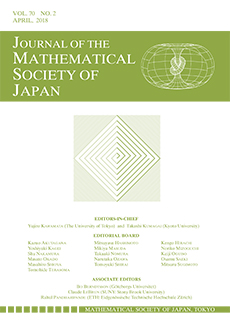Abstract
In this paper, we investigate the asymptotic behavior of regular ends of flat surfaces in the hyperbolic -space . Gálvez, Martínez and Milán showed that when the singular set does not accumulate at an end, the end is asymptotic to a rotationally symmetric flat surface. As a refinement of their result, we show that the asymptotic order (called pitch ) of the end determines the limiting shape, even when the singular set does accumulate at the end. If the singular set is bounded away from the end, we have . If the singular set accumulates at the end, the pitch is a positive rational number not equal to . Choosing appropriate positive integers and so that , suitable slices of the end by horospheres are asymptotic to -coverings (-times wrapped coverings) of epicycloids or -coverings of hypocycloids with cusps and whose normal directions have winding number , where , (, are integers or half-integers) and is the greatest common divisor of and . Furthermore, it is known that the caustics of flat surfaces are also flat. So, as an application, we give a useful explicit formula for the pitch of ends of caustics of complete flat fronts.
Citation
Masatoshi KOKUBU. Wayne ROSSMAN. Masaaki UMEHARA. Kotaro YAMADA. "Asymptotic behavior of flat surfaces in hyperbolic 3-space." J. Math. Soc. Japan 61 (3) 799 - 852, July, 2009. https://doi.org/10.2969/jmsj/06130799
Information





